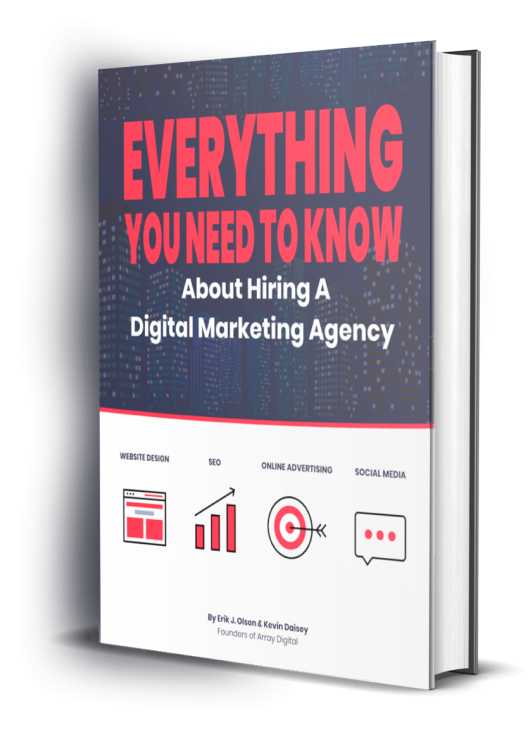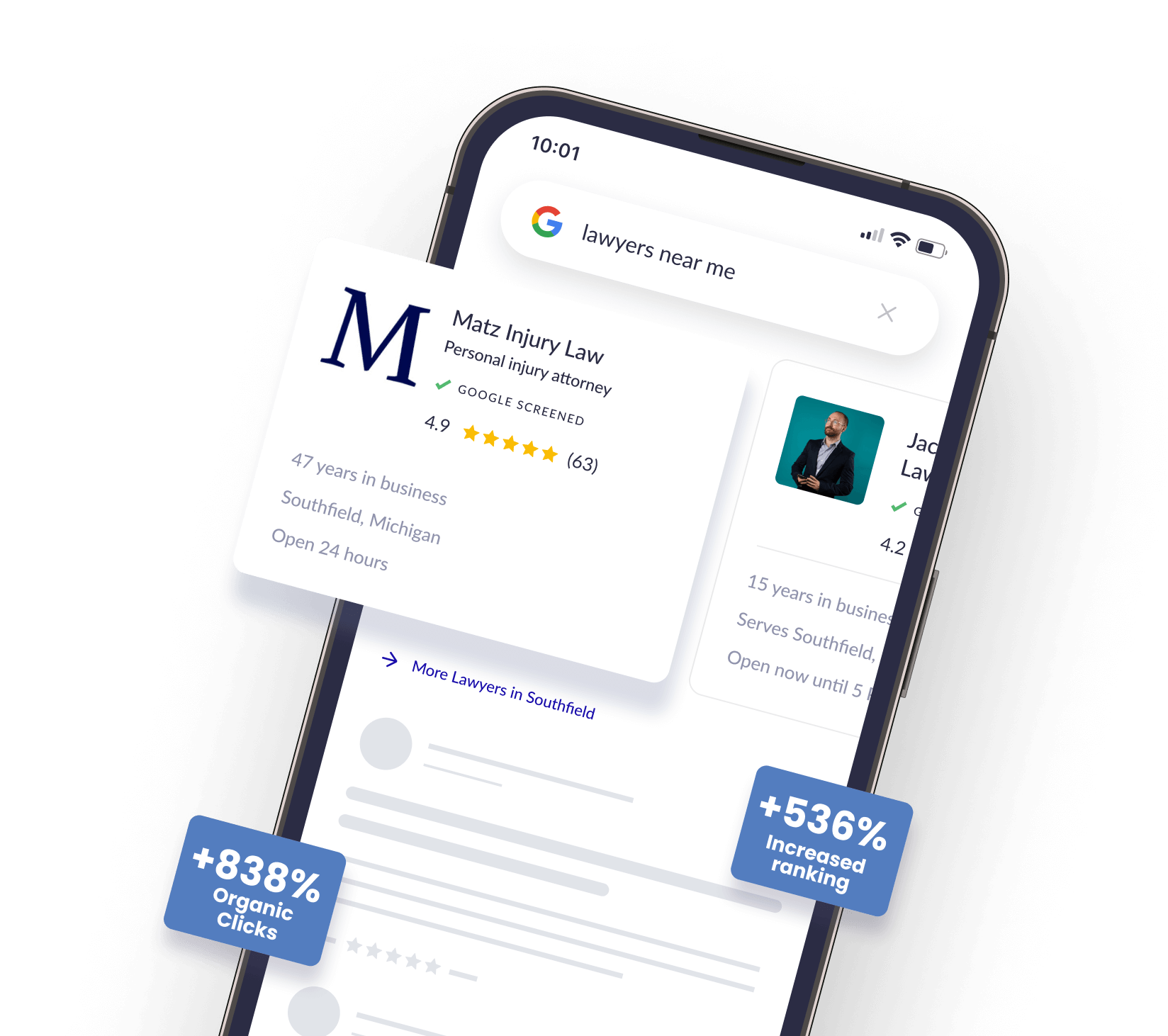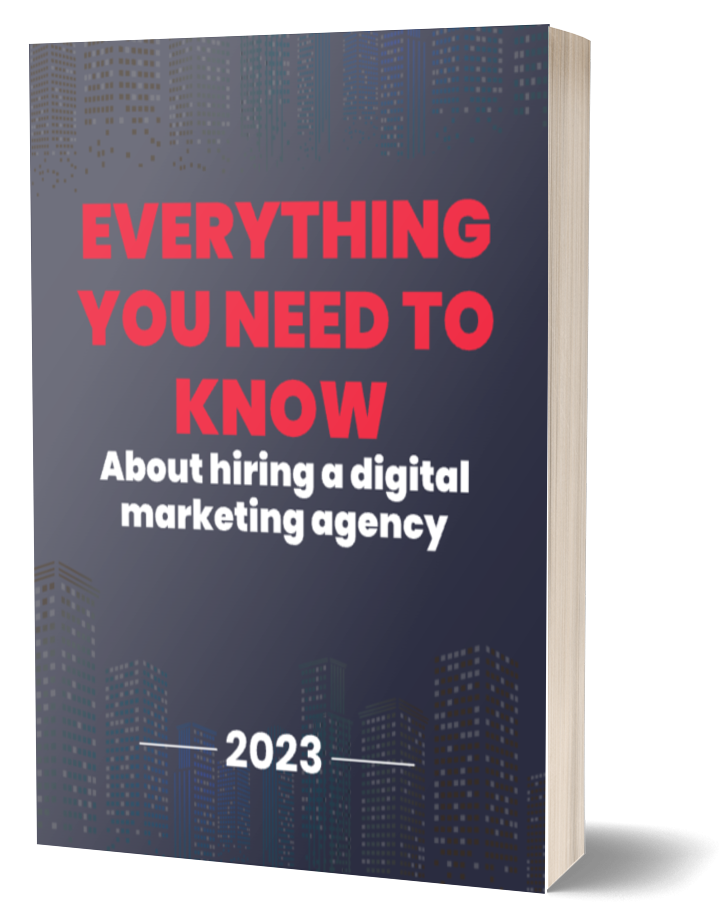
Key Takeaways:
- Law firms need both branding and design to stand out.
- After defining your brand, you can then apply it to your PPC campaigns.
- Properly done, this creates memorable, emotion-building loyalty with those who see your brand.
- Array Digital can help your law firm illuminate your brand through PPC campaigns.
Branding plays a critical role in the success of any marketing campaign, including pay-per-click (PPC) marketing. Without a strong brand, your ads may blend in with competitors, leading to low visibility and recognition.
In addition, users may hesitate to click on ads from unknown or poorly branded sources, fearing scams or low-quality products/services.
Worst of all, without proper branding, your business could have inconsistent messaging that can confuse users, erode trust, and decrease conversion rates.
Thankfully, there are solutions to foster familiarity, trust, and engagement with your audience. This article will discuss why branding matters in PPC and how to maximize your conversion rates.
Understanding brand identity
Brand identity is not just your company’s logo, color scheme, or slogan. It’s the full impression your prospective clients and customers (along with the general public) have of your practice. It consists of numerous attributes that work to make your business distinguishable from others.
View your brand identity as your business’s personality. Any interaction that a person has with your brand identity helps them formulate an opinion that is good or bad and sticks with them for the long term. A positive experience can lead to an important emotional bond between you and those people, and that can foster trustworthiness and loyalty. A bad impression, even if they do not remember the experience, can discourage them from using your services for any reason.
Essential components of brand identity
The importance of a brand identity hinges on what you present to the world. There are several components, then, that make up your identity:
- Your mission
- Your vision
- Target audience
- Brand personality
- Core values
Your mission and vision align with each other to demonstrate why the company exists and where you want the brand to go from here forward.
Target audience refers to the specific set of people you want your services. Understanding your target audience allows you to align your branding more efficiently.
Personality is one that allows you to define your business a bit more fully but with expression. Write down five adjectives that describe your brand the way you want others to experience it. It could be anything from sophisticated and powerful to friendly and welcoming.
Finally, your values must be a set of “rules” that you use to make decisions and actions within your business. By defining this, your team can then make decisions for your company based on your brand.
The importance of brand design
Brand design is the process of defining the visual aspects that represent your firm. This includes your logo, color scheme, typography, and other design elements of your business that help it stand out from the competitors. Branding design is a way for you to express yourself digitally and physically, whether in a local community or on social media.
When you have a clearly defined brand design, you can then leverage it consistently across all touchpoints with your customers and clients. Your brand and business become memorable.
What is a brand style guide, and why do you need one?
A brand style guide outlines all standards set for your brand. The style guide includes rules for:
- Writing
- Formatting
- Design of all aspects of your company
A style guide like this creates uniformity, ensuring that all elements of your brand occur across all aspects of your business.
What are the visual elements of branding?
The visual elements of branding are all aspects that help distinguish your brand from others. They may include:
- Logos
- Color scheme of your business and digital marketing
- Layout of your website
- Typography
- Imagery used
It incorporates any type of visual element that should be consistent across all aspects of your brand as defined within the style guide.
What are the four C’s of the design process?
The four C’s of the design process include:
- Clarity: How clear is it to understand the brand and what the brand stands for?
- Consistency: The brand image, values, and attributes should be consistent across all touchpoints, including all platforms and interactions with clients.
- Content: This defines the focus of the content to reflect and reinforce your brand image.
- Communication: This represents the way in which your organization communicates with the world, how it builds relationships, and how it authentically conveys its message.
Key differences between graphic design and brand design
Don’t confuse graphic design and brand design. Graphic design is the functional “skeleton” of your brand, such as the logo, colors, and shapes used. Branding, by contrast, is the “body and soul” of the brand, which works to build outward the personality of the brand.
Main responsibilities of a graphic designer
The graphic designer typically has the following responsibilities:
- Design the graphics that will be published or printed
- Have a more diverse skillset in areas of illustration, web design, and animation
Main responsibilities of a brand designer
The brand designer will have the following responsibilities:
- Design brand identities for businesses
- They design the logos, colors, and typography used, along with imagery, tone of voice, and design system
What is PPC advertising?
Pay-per-click (PPC) advertising is a form of digital advertising in which you pay a fee every time someone clicks on an ad and visits your website. You set a budget and only pay for clicks, not impressions (how often the ad shows up).
What is PPC for Attorneys?
For attorneys, PPC is a way of placing ads on the internet, including on social media, search engine results pages, and other locations, with the goal of providing a legal solution to a prospective client’s problem. That ad can then direct the potential searcher to your website. You pay every time someone clicks on the ad.
Why strong branding and design are essential to PPC
It may seem like PPC and branding and design are not affiliated with each other. However, in a crowded marketplace, where every attorney’s website seems similar, branding can help your organization stand out from others and help people remember it.
- Trust & credibility: Consumers use brands they trust, and once they lose that trust, they’re not likely to come back.
- Differentiation: How does your brand stand out from others? Why would someone remember it?
- Consistency: Consistency across your brand through all PPC campaigns enables people to remember and connect your services with their needs.
- Emotional connection: Over time, your branding helps to build an emotional connection with the individual.
- Brand association: Over time, that consistency builds a strong association between your brand and problem-solving.
Improve brand identity and increase conversions
Array Digital plays a pivotal role in seamlessly integrating branding and design into pay-per-click (PPC) campaigns. With a keen understanding of your brand’s identity and target audience, we ensure that every PPC campaign drives results and reinforces your brand’s presence and message across digital platforms.
Testimonials
“Array is the expert team that you need to take the complexities of digital marketing off of your plate and bring customers that need you to your doorstep.” –Greg T.
“Erik and his team at Array Digital are extremely knowledgeable in the area of marketing and all of the facets that are needed to help businesses grow and promote their brand.” – Morris W.
Why waste time? Get the most out of your PPC efforts today
Array Digital crafts compelling ad creatives, optimizes landing pages, and utilizes ad extensions to ensure consistent branding and visually engaging experiences. Connect with us here, or give us a call today to get started at 757-333-3021.
Frequently Asked Questions
Branding and design are the processes used to help create a visual and emotional impact on others when they see your logo, messages, or ads. They influence consumer perception of your value and service while also driving loyalty.
Branding is the identity of your law firm, whereas marketing refers to the methods and strategies used to communicate your brand to the audience. Branding is a form of marketing.
Design concept refers to the idea behind the brand. It is the use of sketches, images, words, and other details to help design the brand itself.
-
Uncategorized
-
PPC
-
SEO
-
Website Design
-
Digital Marketing
-
Social Media
-
Advertising
-
Entrepreneurship
-
Content

Everything you need to know about hiring a digital marketing agency:
- The four pillars of digital marketing
- Digital marketing options and costs
- The pitfalls to avoid
- What to expect when working with an agency
- The qualities to look for in a digital marketing agency

Related Uncategorized Articles
Extraordinary Results
“Erik and the Array Digital team are top notch in the digital marketing spaces, particularly for SEO. Their understanding of Google, the algorithms, and the work involved to get websites ranking on the first page is unparalleled. Thank you Erik!!”
“I had a chance to consult with Kevin Daisey for my law firm’s marketing needs. He is knowledgeable, kind, and helpful. He provided me with a great marketing analysis. He also invited me to their podcast as a guest speaker. Thank you Array Digital!”
“The legal profession needs more architects and designers…folks who are thinking about the future of the profession and who are assembling a tribe of like minded lawyer leaders. Erik and his team are certainly ‘that’.”








